Spatial and Seasonal Changes in Microbial Community of Hynobius amjiensis Breeding Pools in a Sphagnum-Dominated Peatland
Abstract
:1. Introduction
2. Materials and Methods
2.1. Study Area
2.2. Water Sampling and Analysis
2.3. DNA Extraction, Illumina High-Throughput Sequencing
2.4. Microbial Network Creation
2.5. Statistical Analysis
3. Results
3.1. Egg Sacs and Water Quality in Breeding Pools
3.2. Microbial Diversity and Community Structure
3.3. Microbial Community Composition
3.4. Correlation between Microbial Community and Water Properties
3.5. Topological Properties of Microbial Networks
4. Discussion
4.1. Seasonal and Spatial Variation of Water Quality in Breeding Pools
4.2. Variations in Microbial Communities
4.3. The Effects of Water Quality on Egg Sacs of Hynobius amjiensis
5. Conclusions
Supplementary Materials
Author Contributions
Funding
Data Availability Statement
Conflicts of Interest
References
- Dieleman, C.M.; Branfireun, B.A.; McLaughlin, J.W.; Lindo, Z. Climate change drives a shift in peatland ecosystem plant community: Implications for ecosystem function and stability. Glob. Change Biol. 2015, 21, 388–395. [Google Scholar] [CrossRef]
- Laine, A.M.; Lindholm, T.; Nilsson, M.; Kutznetsov, O.; Jassey, V.E.J.; Tuittila, E.S.; Gilliam, F. Functional diversity and trait composition of vascular plant and Sphagnum moss communities during peatland succession across land uplift regions. J. Ecol. 2021, 109, 1774–1789. [Google Scholar] [CrossRef]
- Ma, X.Y.; Xu, H.; Cao, Z.Y.; Shu, L.; Zhu, R.L. Will climate change cause the global peatland to expand or contract? Evidence from the habitat shift pattern of Sphagnum mosses. Glob. Change Biol. 2022, 28, 6419–6432. [Google Scholar] [CrossRef] [PubMed]
- Yu, M.; Yue, X.; Wang, T.; Shen, Q.; Wang, X.; Wu, Y. Different vegetation communities did not amplify spatial heterogeneity of soil microbial diversity and community in a subtropical Sphagnum-dominated peatland. Plant Soil 2023, 495, 271–285. [Google Scholar] [CrossRef]
- Minasny, B.; Berglund, Ö.; Connolly, J.; Hedley, C.; de Vries, F.; Gimona, A.; Kempen, B.; Kidd, D.; Lilja, H.; Malone, B.; et al. Digital mapping of peatlands—A critical review. Earth Sci. Rev. 2019, 196, 102870. [Google Scholar] [CrossRef]
- Gu, H. A new species in the genus Hynobius, H. amjiensis. In China Zoological Society; Zoological Science Research; Chinese Forestry Press: Beijing, China, 1992; pp. 39–43. [Google Scholar]
- Cao, Z.; Guo, R.; Fang, Z.; Wang, Z.; Liu, Y.; Lin, L.; Ji, X. Normal table of embryonic development in the Anji salamander Hynobius amjiensis (Hynobiidae). Devel. Biol. 2024, 511, 84–91. [Google Scholar] [CrossRef] [PubMed]
- Chen, C.; Yang, J.; Wu, Y.; Fan, Z.; Lu, W.; Chen, S.; Yu, L. The breeding ecology of a critically endangered salamander Hynobius amjiensis (Caudata: Hynobiidae), endemic to Eastern China. Asian Herpetol. Res. 2016, 7, 53–58. [Google Scholar]
- Resetarits, W.J.J.; Wilbur, H.M. Choice of oviposition site by Hyla chrysoscelis: Role of predators and competitors. Ecology 1989, 70, 220–228. [Google Scholar] [CrossRef]
- IUCN SSC Amphibian Specialist Group. Hynobius amjiensis. The IUCN Red List of Threatened Species. 2021, e.T59089A63876823. Available online: https://www.iucnredlist.org/species/59089/63876823 (accessed on 28 June 2024).
- Wu, J. The hazard and unsureness of reducing habitat ranges in response to climate warming for 91 amphibian species in China. Acta Oecol. 2020, 108, 103640. [Google Scholar] [CrossRef]
- Tian, W.; Li, Q.; Luo, Z.; Wu, C.; Sun, B.; Zhao, D.; Chi, S.; Cui, Z.; Xu, A.; Song, Z. Microbial community structure in a constructed wetland based on a recirculating aquaculture system: Exploring spatio-temporal variations and assembly mechanisms. Mar. Environ. Res. 2024, 197, 106413. [Google Scholar] [CrossRef]
- Liu, N.; Wang, B.; Yang, M.; Li, W.; Shi, X.; Liu, C.-Q. The different responses of planktonic bacteria and archaea to water temperature maintain the stability of their community diversity in dammed rivers. Ecol. Process. 2023, 12, 25. [Google Scholar] [CrossRef]
- Zou, S.; Lian, Q.; Ni, M.; Zhou, D.; Liu, M.; Zhang, X.; Chen, G.; Yuan, J. Spatiotemporal assembly and functional composition of planktonic microeukaryotic communities along productivity gradients in a subtropical lake. Front. Microbiol. 2024, 15, 1351772. [Google Scholar] [CrossRef] [PubMed]
- Su, W.Q.; Yu, M.; Lin, J.; Tang, C.; Xu, J. Fire decreases gross mineralization rate but does not alter gross nitrification rate in boreal forest soils. Soil Biol. Biochem. 2022, 175, 108838. [Google Scholar] [CrossRef]
- Mu, X.; Zhang, S.; Lv, X.; Ma, Y.; Zhang, Z.; Han, B. Water flow and temperature drove epiphytic microbial community shift: Insight into nutrient removal in constructed wetlands from microbial assemblage and co-occurrence patterns. Bioresour. Technol. 2021, 332, 125134. [Google Scholar] [CrossRef] [PubMed]
- Ding, L.; Wang, Z.; Zhou, G.; Du, Q. Monitoring Phyllostachys pubescens stands expansion in National Nature Reserve of Mount Tianmu by remote sensing. J. Zhejiang For. Coll. 2006, 23, 297–300. [Google Scholar]
- Bolyen, E.; Rideout, J.R.; Dillon, M.R.; Bokulich, N.A.; Abnet, C.C.; Al-Ghalith, G.A.; Alexander, H.; Alm, E.J.; Arumugam, M.; Asnicar, F.; et al. Reproducible, interactive, scalable and extensible microbiome data science using QIIME 2. Nat. Biotechnol. 2019, 37, 852–857. [Google Scholar] [CrossRef]
- Callahan, B.J.; McMurdie, P.J.; Rosen, M.J.; Han, A.W.; Johnson, A.J.; Holmes, S.P. DADA2: High-resolution sample inference from Illumina amplicon data. Nat. Methods 2016, 13, 581–583. [Google Scholar] [CrossRef] [PubMed]
- Katoh, K.; Misawa, K.; Kuma, K.; Miyata, T. MAFFT: A novel method for rapid multiple sequence alignment based on fast Fourier transform. Nucleic Acids Res. 2002, 30, 3059–3066. [Google Scholar] [CrossRef]
- Bokulich, N.A.; Kaehler, B.D.; Rideout, J.R.; Dillon, M.; Bolyen, E.; Knight, R.; Huttley, G.A.; Caporaso, J.G. Optimizing taxonomic classification of marker-gene amplicon sequences with QIIME 2’s q2-feature-classifier plugin. Microbiome 2018, 6, 90. [Google Scholar] [CrossRef]
- Quast, C.; Pruesse, E.; Yilmaz, P.; Gerken, J.; Schweer, T.; Yarza, P.; Peplies, J.; Glockner, F.O. The SILVA ribosomal RNA gene database project: Improved data processing and web-based tools. Nucleic Acids Res. 2013, 41, D590–D596. [Google Scholar] [CrossRef]
- Camacho, C.; Coulouris, G.; Avagyan, V.; Ma, N.; Papadopoulos, J.; Bealer, K.; Madden, T.L. BLAST+: Architecture and applications. BMC Bioinf. 2009, 10, 421. [Google Scholar] [CrossRef] [PubMed]
- Guillou, L.; Bachar, D.; Audic, S.; Bass, D.; Berney, C.; Bittner, L.; Boutte, C.; Burgaud, G.; de Vargas, C.; Decelle, J.; et al. The Protist Ribosomal Reference database (PR2): A catalog of unicellular eukaryote small sub-unit rRNA sequences with curated taxonomy. Nucleic Acids Res. 2013, 41, D597–D604. [Google Scholar] [CrossRef] [PubMed]
- Benjamini, Y.; Hochberg, Y. Controlling the false discovery rate—A practical and powerful approach to multiple testing. J. R. Stat. Soc. Ser. B Stat. Methodol. 1995, 57, 289–300. [Google Scholar] [CrossRef]
- Harrell, F.E., Jr.; Harrell, M.F.E., Jr. Package ‘Hmisc’, CRAN2018; The R Foundation: Vienna, Australia, 2019; pp. 235–236. [Google Scholar]
- Csardi, G.; Nepusz, T. The igraph software package for complex network research. InterJ. Complex Syst. 2006, 1695, 1–9. [Google Scholar]
- Bastian, M.; Heymann, S.; Jacomy, M. Gephi: An open source software for exploring and manipulating networks. In Proceedings of the Third International AAAI Conference on Weblogs and Social Media, San Jose, CA, USA, 17–20 May 2009. [Google Scholar]
- Oksanen, J.; Kindt, R.; Legendre, P.; O’Hara, B.; Stevens, M.H.H.; Oksanen, M.J.; Suggests, M. The vegan package. Community Ecol. Package 2007, 10, 631–637. [Google Scholar]
- Gu, Z.; Gu, L.; Eils, R.; Schlesner, M.; Brors, B. “Circlize” implements and enhances circular visualization in R. Bioinformatics 2014, 30, 2811–2812. [Google Scholar] [CrossRef] [PubMed]
- Revelle, W.; Revelle, M.W. Package ‘psych’; The Comprehensive R Archive Network: Vienna, Australia, 2015. Available online: https://cran.r-project.org/web/packages/psych/index.html (accessed on 28 June 2024).
- Wickham, H.; Chang, W.; Wickham, M.H. Package ggplot2. Create Elegant Data Visualisations Using the Grammar of Graphics, Version 2; 2016; pp. 1–189. Available online: https://ggplot2.tidyverse.org/reference/ggplot2-package.html (accessed on 28 June 2024).
- Xu, W.; Duan, L.; Wen, X.; Li, H.; Li, D.; Zhang, Y.; Zhang, H. Effects of seasonal variation on water quality parameters and eutrophication in Lake Yangzong. Water 2022, 14, 2732. [Google Scholar] [CrossRef]
- Rodgers, E.M. Adding climate change to the mix: Responses of aquatic ectotherms to the combined effects of eutrophication and warming. Biol. Lett. 2021, 17, 20210442. [Google Scholar] [CrossRef]
- Diaz, R.J.; Rosenberg, R. Spreading dead zones and consequences for marine ecosystems. Science 2008, 321, 926–929. [Google Scholar] [CrossRef]
- Brisson, J.; Rodriguez, M.; Martin, C.A.; Proulx, R. Plant diversity effect on water quality in wetlands: A meta-analysis based on experimental systems. Ecol. Appl. 2020, 30, e02074. [Google Scholar] [CrossRef]
- Clairmont, L.K.; Slawson, R.M. Contrasting water quality treatments result in structural and functional changes to wetland plant-associated microbial communities in lab-scale mesocosms. Microb. Ecol. 2020, 79, 50–63. [Google Scholar] [CrossRef] [PubMed]
- Liu, Y.; Gong, L.; Mu, X.; Zhang, Z.; Zhou, T.; Zhang, S. Characterization and co-occurrence of microbial community in epiphytic biofilms and surface sediments of wetlands with submersed macrophytes. Sci. Total Environ. 2020, 715, 136950. [Google Scholar] [CrossRef] [PubMed]
- Petersen, J.; Ludewig, A.K.; Michael, V.; Bunk, B.; Jarek, M.; Baurain, D.; Brinkmann, H. Chromera velia, endosymbioses and the rhodoplex hypothesis-plastid evolution in cryptophytes, alveolates, stramenopiles, and haptophytes (CASH lineages). Genome Biol. Evol. 2014, 6, 666–684. [Google Scholar] [CrossRef]
- Yu, M.; Su, W.Q.; Huang, L.; Parikh, S.J.; Tang, C.; Dahlgren, R.A.; Xu, J. Bacterial community structure and putative nitrogen-cycling functional traits along a charosphere gradient under waterlogged conditions. Soil Biol. Biochem. 2021, 162, 108420. [Google Scholar] [CrossRef]
- Hernandez, D.J.; David, A.S.; Menges, E.S.; Searcy, C.A.; Afkhami, M.E. Environmental stress destabilizes microbial networks. ISME J. 2021, 15, 1722–1734. [Google Scholar] [CrossRef]
- de Vries, F.T.; Griffiths, R.I.; Bailey, M.; Craig, H.; Girlanda, M.; Gweon, H.S.; Hallin, S.; Kaisermann, A.; Keith, A.M.; Kretzschmar, M.; et al. Soil bacterial networks are less stable under drought than fungal networks. Nat. Commun. 2018, 9, 3033. [Google Scholar] [CrossRef]
- Hamard, S.; Robroek, B.J.M.; Allard, P.M.; Signarbieux, C.; Zhou, S.; Saesong, T.; de Baaker, F.; Buttler, A.; Chiapusio, G.; Wolfender, J.L.; et al. Effects of Sphagnum leachate on competitive Sphagnum microbiome depend on species and time. Front. Microbiol. 2019, 10, 2042. [Google Scholar] [CrossRef]
- Jarvie, H.P.; Pallett, D.W.; Schafer, S.M.; Macrae, M.L.; Bowes, M.J.; Farrand, P.; Warwick, A.C.; King, S.M.; Williams, R.J.; Armstrong, L.; et al. Biogeochemical and climate drivers of wetland phosphorus and nitrogen release: Implications for nutrient legacies and eutrophication risk. J. Environ. Qual. 2020, 49, 1703–1716. [Google Scholar] [CrossRef] [PubMed]
- Nagel, L.D.; McNulty, S.A.; Schlesinger, M.D.; Gibbs, J.P. Breeding effort and hydroperiod indicate habitat quality of small, isolated wetlands for amphibians under climate extremes. Wetlands 2021, 41, 22. [Google Scholar] [CrossRef]
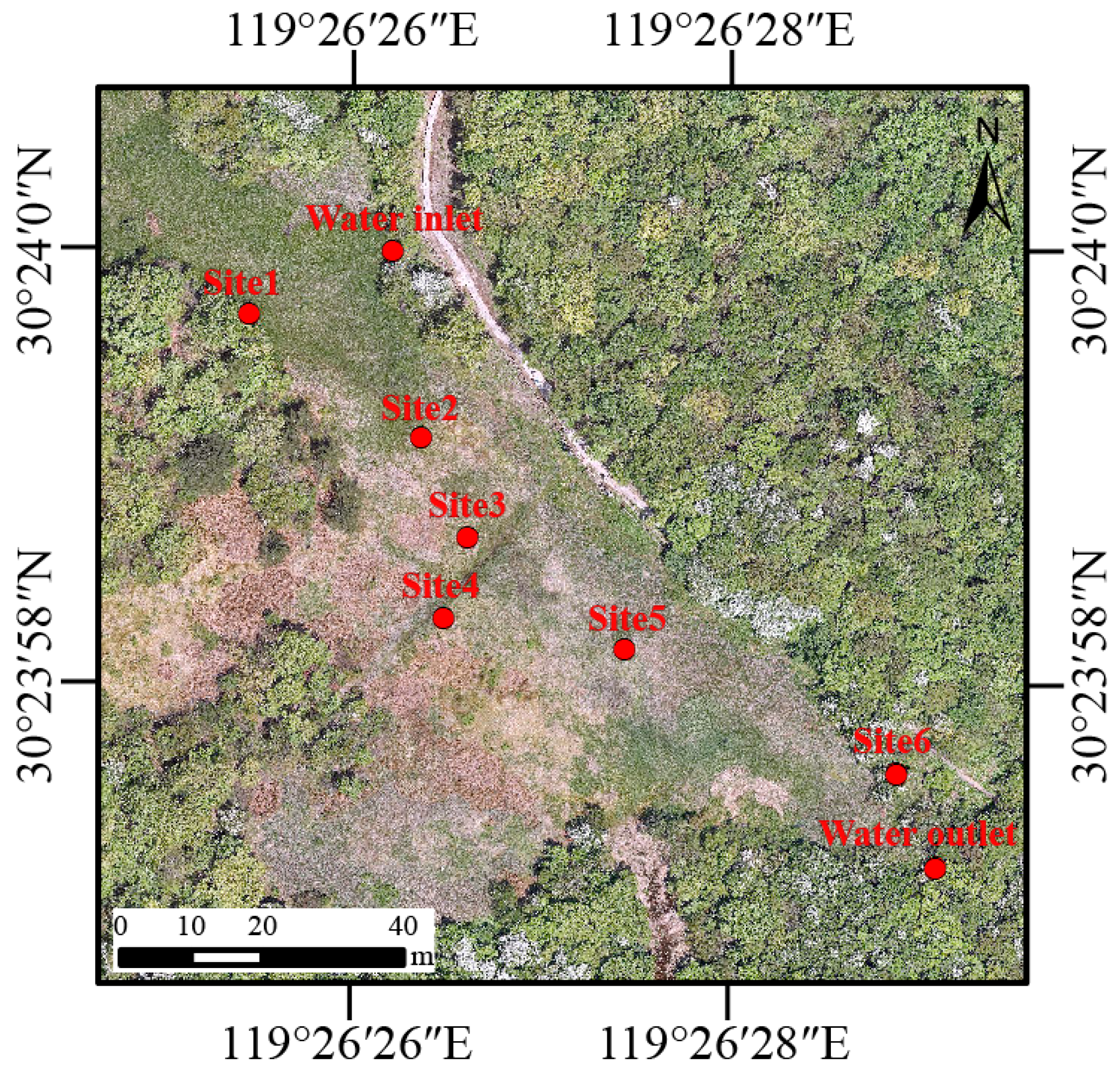
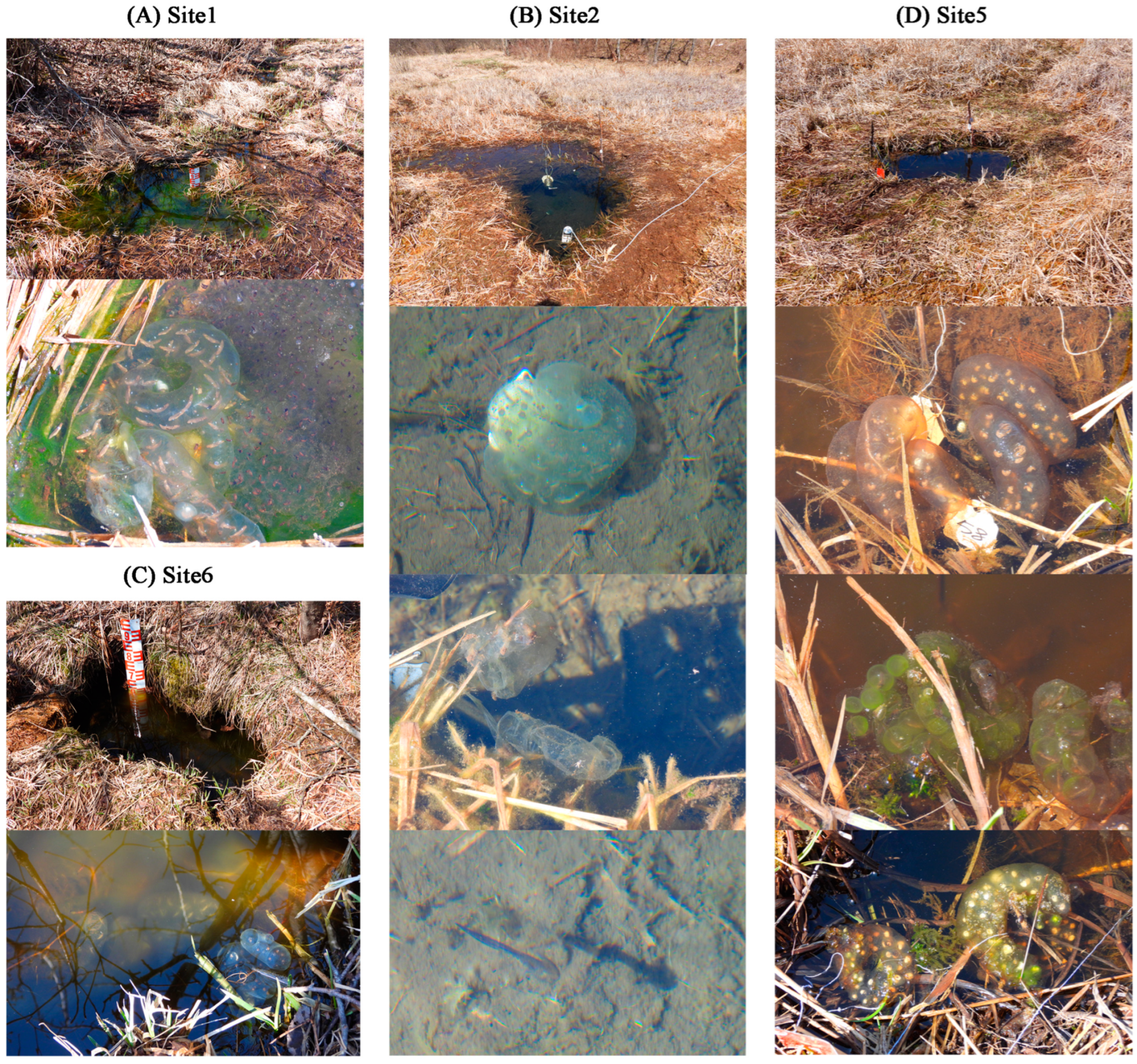

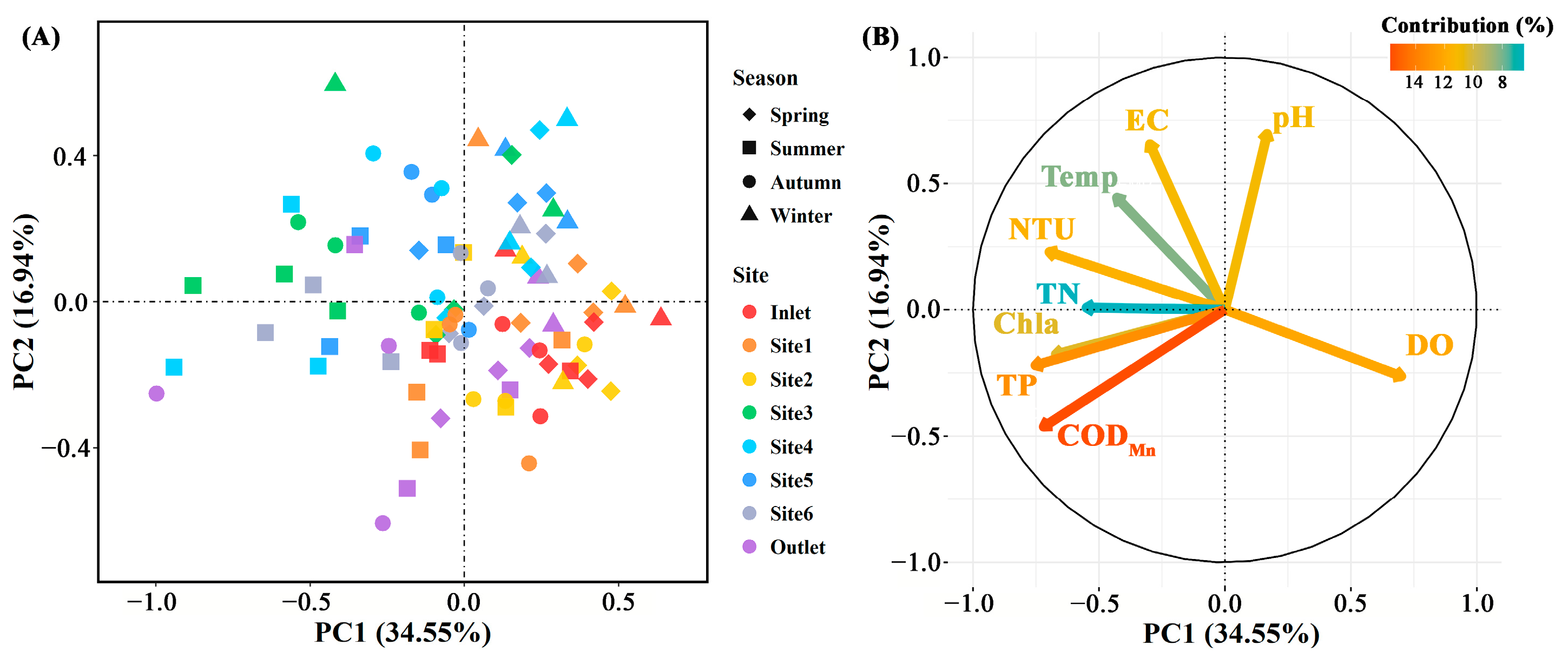
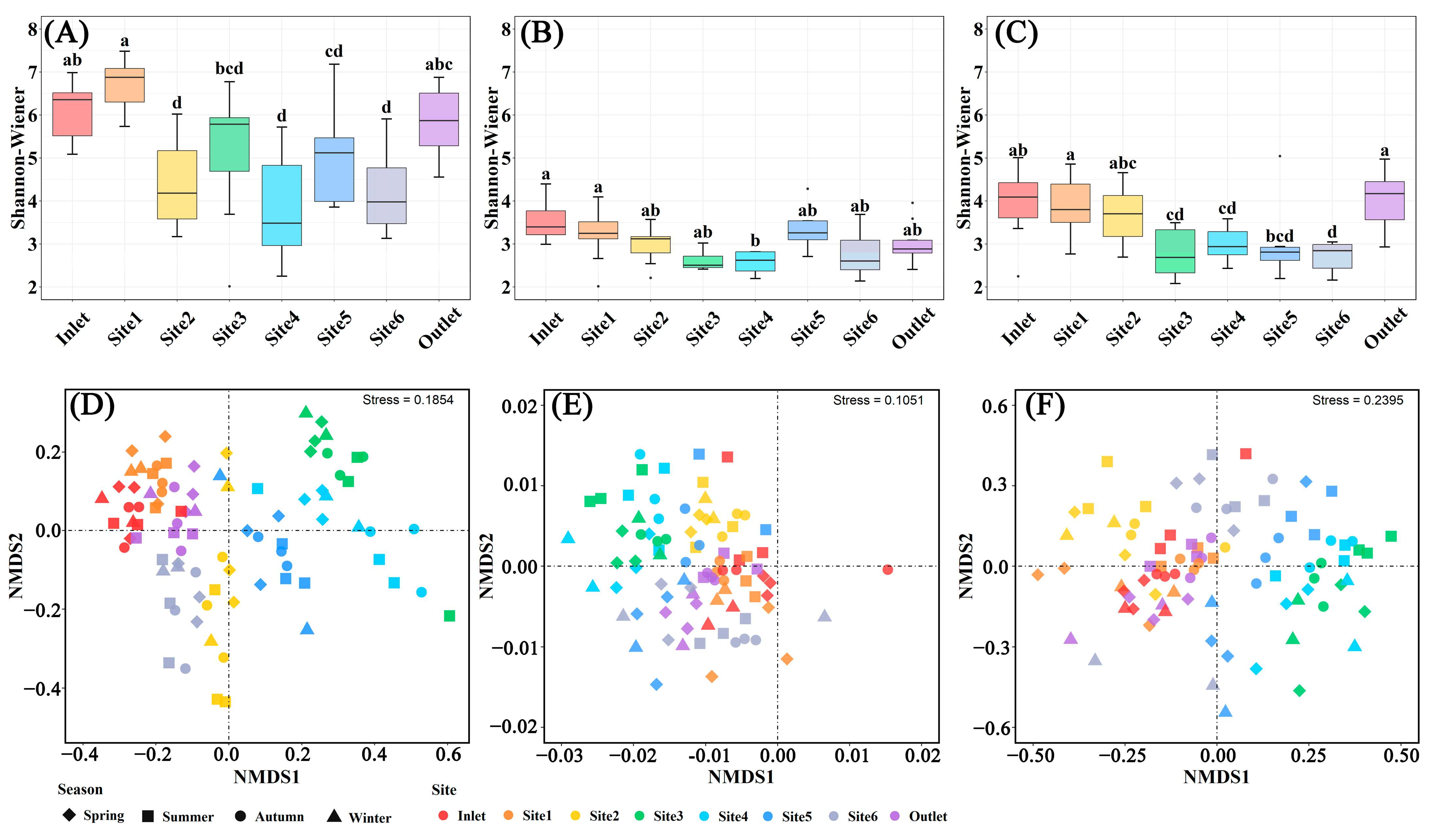


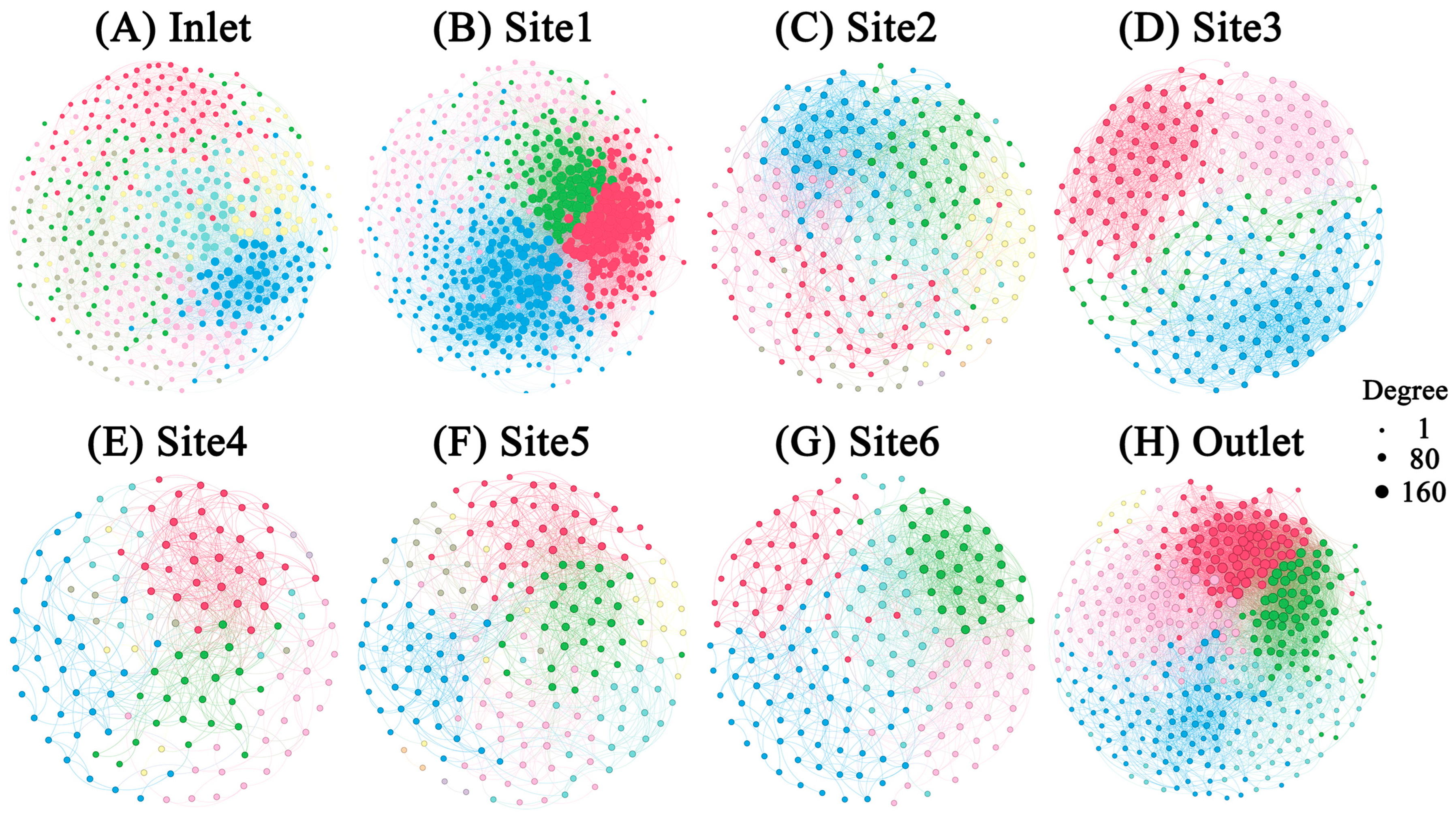
| Water Properties | Bacteria | Fungi | Protist | |||
|---|---|---|---|---|---|---|
| R | p 1 | R | p | R | p | |
| All | 0.283 | <0.001 | −0.009 | n.s. | 0.007 | n.s. |
| pH | 0.052 | n.s. 2 | −0.008 | n.s. | 0.007 | n.s. |
| Temp | 0.129 | 0.007 | 0.117 | 0.010 | 0.068 | 0.008 |
| DO | 0.055 | n.s. | −0.018 | n.s. | 0.019 | n.s. |
| EC | −0.018 | n.s. | −0.007 | n.s. | −0.017 | n.s. |
| NTU | 0.000 | n.s. | −0.040 | n.s. | −0.009 | n.s. |
| Total N | 0.037 | n.s. | −0.057 | n.s. | −0.025 | n.s. |
| Total P | 0.188 | 0.002 | −0.007 | n.s. | 0.004 | n.s. |
| CODMn | 0.216 | <0.001 | 0.035 | n.s. | 0.044 | n.s. |
| Chla | 0.335 | <0.001 | 0.038 | n.s. | 0.025 | n.s. |
| Topological Properties | Inlet | Site 1 | Site 2 | Site 3 | Site 4 | Site 5 | Site 6 | Outlet |
|---|---|---|---|---|---|---|---|---|
| Numbers of modules (containing more than 5 nodes) | 7 | 4 | 7 | 4 | 5 | 7 | 5 | 6 |
| Number of nodes | 463 | 594 | 249 | 240 | 138 | 189 | 186 | 413 |
| Number of edges | 5466 | 15,270 | 2110 | 2508 | 638 | 1137 | 1351 | 7548 |
| Positive edges (%) | 28.8 | 31.8 | 20.4 | 29.5 | 22.6 | 25.9 | 25.7 | 34.8 |
| Negative edges (%) | 71.2 | 68.2 | 79.6 | 70.5 | 77.4 | 74.1 | 74.3 | 65.2 |
| Average degree | 23.61 | 51.41 | 16.95 | 20.90 | 9.25 | 12.03 | 14.53 | 36.55 |
| Modularity | 0.427 | 0.391 | 0.439 | 0.611 | 0.428 | 0.496 | 0.425 | 0.396 |
| Average betweenness centrality | 441.3 | 460.5 | 234.1 | 238.4 | 159.8 | 186.2 | 192.3 | 351.9 |
| Average closeness centrality | 0.349 | 0.399 | 0.359 | 0.338 | 0.311 | 0.348 | 0.334 | 0.379 |
| Average clustering coefficient | 0.390 | 0.471 | 0.448 | 0.565 | 0.399 | 0.453 | 0.469 | 0.491 |
| Average path distance | 2.910 | 2.553 | 2.950 | 2.995 | 3.333 | 3.068 | 3.079 | 2.708 |
Disclaimer/Publisher’s Note: The statements, opinions and data contained in all publications are solely those of the individual author(s) and contributor(s) and not of MDPI and/or the editor(s). MDPI and/or the editor(s) disclaim responsibility for any injury to people or property resulting from any ideas, methods, instructions or products referred to in the content. |
© 2024 by the authors. Licensee MDPI, Basel, Switzerland. This article is an open access article distributed under the terms and conditions of the Creative Commons Attribution (CC BY) license (https://creativecommons.org/licenses/by/4.0/).
Share and Cite
Yu, M.-J.; Wang, X.-T.; Wang, T.; Huang, W.-Q.; Lang, Z.-D.; Wang, J.-P.; Wu, Y.-H. Spatial and Seasonal Changes in Microbial Community of Hynobius amjiensis Breeding Pools in a Sphagnum-Dominated Peatland. Microorganisms 2024, 12, 1344. https://doi.org/10.3390/microorganisms12071344
Yu M-J, Wang X-T, Wang T, Huang W-Q, Lang Z-D, Wang J-P, Wu Y-H. Spatial and Seasonal Changes in Microbial Community of Hynobius amjiensis Breeding Pools in a Sphagnum-Dominated Peatland. Microorganisms. 2024; 12(7):1344. https://doi.org/10.3390/microorganisms12071344
Chicago/Turabian StyleYu, Meng-Jie, Xian-Ting Wang, Ting Wang, Wei-Quan Huang, Ze-Dong Lang, Jia-Peng Wang, and Yu-Huan Wu. 2024. "Spatial and Seasonal Changes in Microbial Community of Hynobius amjiensis Breeding Pools in a Sphagnum-Dominated Peatland" Microorganisms 12, no. 7: 1344. https://doi.org/10.3390/microorganisms12071344





